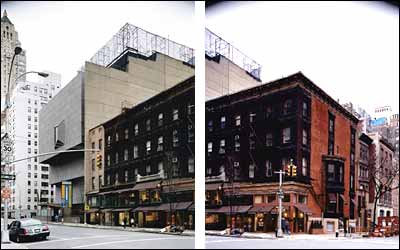
(Photo credit: From left, Courtesy of Renzo Piano Building Workshop, Architects and the Whitney Museum of American Art)
One of the chief weapons that preservationists have to wield against the Whitney Museum’s expansion plan is the extra-stringent bureaucratic designation “contributing building.” It’s basically a get-out-of-jail-free card for pretty old buildings threatened with demolition. Because the Whitney’s in the Upper East Side Historic District, known for a hyperawareness of its own inviolable continuity, the museum’s request to tear down two of the six neighboring brownstones it owns to build its Renzo Piano–designed extension was going to be endlessly reviewed already. But one of the two doomed structures, 941 Madison, has that “contributing” designation. Like some 1,800 buildings in the district, it’s earned the label because of artistic, historical, or cultural merit. And in 40 years of decision-making, the Landmarks Preservation Commission has never issued a certificate of appropriateness to allow for the razing of a contributing building.
The other address on the chopping block, 943 Madison, is considered to have “no style” (another official bureaucratic designation) because in 1927 its owner removed its window details and roof cornice in a renovation. Next door, 941 derives its special rights from retaining the neo-Grec decorative flourishes it had when it was constructed in 1876 by architect S. M. Styles. It’s difficult to identify those details now—the Whitney has covered 941 (along with the other four soon-to-be-gutted buildings that will keep their contributing façades but sit under the new tower) with a black netting to prevent chunks of the decorative details from falling. Behind that veil, you’d see full window enframements with lintels, a bracketed cornice, and a balustrade and cartouche above the second floor.
“We talked about just knocking down the one noncontributing building to make a sixteen-foot-wide entry,” says Whitney director Adam Weinberg. “Those brownstones aren’t the greatest of all historical monuments, but they’re important to the neighborhood.” But “a sixteen-foot walkway next to that 90-foot wall would make an alleylike space. Not a very pleasant entrance. There would be wheelchair-accessibility and security problems. Renzo said we need 24 or 25 feet; can we cut one brownstone in half? That’s defensible, cutting a contributing brownstone in half.”
Or at least he hopes the commission will see it that way. But Simeon Bankoff, Historic Districts Council head, doesn’t want to lose that cartouche. “It has nothing to do with a proposed building’s function,” he says, adding sarcastically, “Yippee! The Whitney is a valuable cultural institution! It has everything to do with the architecture.”